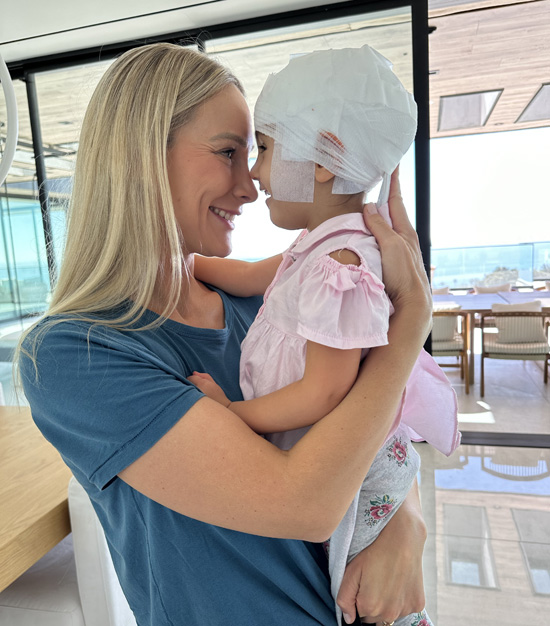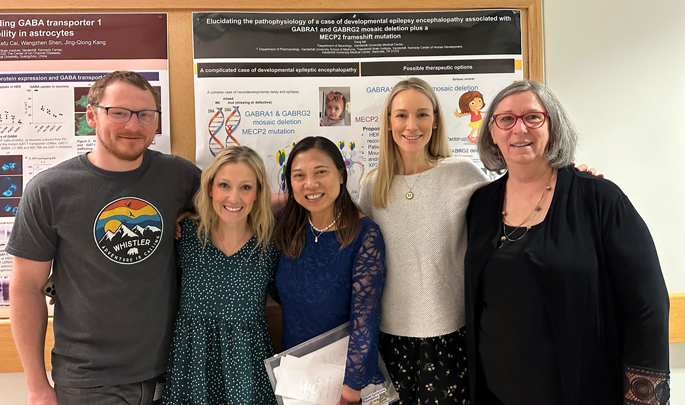Something was wrong. Eleanor had not begun to walk or form words. Her behavior and mannerisms were unusual for an 18-month-old.
Her checkups were normal, but her mother, Monica Joanna Elnekaveh, of Malibu, California, dove into the medical literature. She pushed for more testing — more lab work, an MRI, an EEG and, finally, whole exome sequencing, a complete readout of the child’s DNA.

That’s when they found it. Eleanor carried mutations in two subunit genes for the GABA A receptor, which binds gamma-aminobutyric acid, the major inhibitory neurotransmitter in the central nervous system. Mutations in this receptor have been linked to epilepsy and neurodevelopmental conditions, including autism and intellectual disability.
While Eleanor’s condition was rare, single gene mutations associated with childhood epilepsy have been reported to occur in one out of every 2,000 births. Traditional epilepsy treatments are limited in their ability to prevent seizures in children with these mutations.
Elnekaveh was told she would have to wait for research to come up with an effective therapy. But waiting is not part of her vocabulary. “I can’t control my daughter’s diagnosis,” she said, “but I can control what I’m going to do.”
She went back to the journals, and laboriously taught herself complex medical jargon. There she discovered the work of investigative neurologist Jing-Qiong (Katty) Kang, MD, PhD, associate professor of Neurology and Pharmacology at Vanderbilt University Medical Center.
Kang, who trained at Tongji Medical University in Wuhan, China, has been studying GABA A receptor mutations since 2003, when she joined the lab of Robert Macdonald, MD, PhD, then chair of Neurology at VUMC, as a postdoctoral fellow.
In 2011, she received a seed grant from the Vanderbilt Institute for Clinical and Translational Research to study 4-phenylbutyrate (PBA), a drug previously approved for treating urea cycle disorders and sickle cell anemia in children, as a possible therapy for genetic epilepsy.
Eight years later, Kang and her colleagues discovered that a patient with a severe seizure disorder had a mutation in the gene for a GABA transporter protein that disrupted the reuptake of the GABA neurotransmitter from the synapse, or gap between nerve cells, and altered GABA signaling in the brain.

In 2021, further research from the Kang lab identified a common pathological mechanism underlying a spectrum of epilepsy syndromes and neurodevelopmental disorders that was associated with variations in the transporter gene, SLC6A1.
Their findings suggested that boosting transporter function via genetic or pharmacological means could be beneficial in treating brain disorders linked to these genetic variants.
The next year she and her colleagues were the first in the world to report that PBA increased GABA reuptake and reduced the severity of seizures in preclinical models of seizure disorders associated with SLC6A1 variants.
Their discoveries provided the scientific basis for an ongoing clinical trial of the drug in children with SLC6A1 variant-linked seizure disorders and neurodevelopmental delay.
In January 2023, Eleanor had her first full-blown, tonic-clonic seizure. Her lips turned purple. She lost consciousness. At first her muscles stiffened, then her arms and legs began jerking wildly.
“I picked her up,” her mother recalled. “I thought she was dying in my arms.”
After a few minutes, the convulsions stopped. The frightening episode made Elnekaveh more determined to find a way to help her daughter, now nearly 3, and others like her.
She formed a nonprofit organization, Cure GABA A Variants, to raise public awareness, provide information to parents, and help support research.
She met with other mothers who advocated on behalf of their children with rare genetic conditions, and she visited Kang’s lab. In October, Kang received a research grant from Cure GABA A Variants.
Kang has received major funding from the federal government, including in 2022 a five-year, $2-million grant from the National Institute of Neurological Disorders and Stroke, part of the National Institutes of Health, to study the effectiveness of PBA in laboratory and mouse models of genetic epilepsy.
Her lab also received a research award and generous donation from SLC6A1 Connect, a Denver-based patient organization established by Amber Freed, whose 6-year-old son Maxwell has a severe form of epilepsy caused by an SLC6A1 mutation.
The grant from Cure GABA A Variants is not only a continuation of those efforts. “This is foundational, and the impact will be long-lasting,” Kang said. “This provides an excellent opportunity to further our international collaboration and help children with GABAA receptor pathological variants worldwide.”
Elnekaveh and Freed have joined forces with Terry Jo Bichell, PhD, MPH, who established a Brentwood, Tennessee, based nonprofit called COMBINEDBrain in 2019 to “speed the path” to clinical testing and new treatments for people with neurodevelopmental disorders like her son Lou, who was diagnosed with Angelman syndrome.
Together they are hosting a Dec. 3 panel discussion on genetic epilepsy at the American Epilepsy Society’s annual meeting in Orlando. Kang will present her latest research findings.
“We’re building this infrastructure from scratch,” Elnekaveh said. “If I wanted to help my daughter in any way, my family would have to start funding research. We’re hoping people will follow suit.”
“We’re just moms, fighting for our children’s lives,” Freed said. Supporting research provides the opportunity for scientists “to look at the disease through a different lens, and (perhaps) solve a tiny piece of the puzzle. Dr. Kang is a hero for our community.”
To Kang, mothers like Monica, Amber and Terry Jo are the real heroes.
“We work as one family,” Kang said, “to find a cure for children who suffer from rare genetic epilepsy.”












